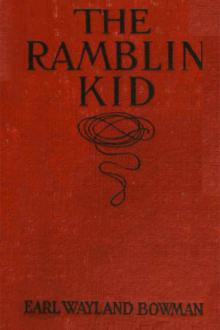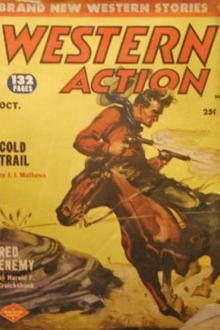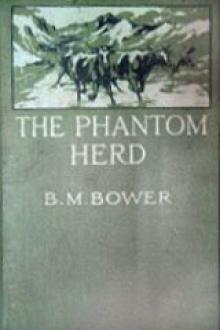Spinifex and Sand<br />A Narrative of Five Years' Pioneering and Exploration in Western Ausralia, David Wynford Carnegie [best novels in english .txt] 📗

- Author: David Wynford Carnegie
Book online «Spinifex and Sand<br />A Narrative of Five Years' Pioneering and Exploration in Western Ausralia, David Wynford Carnegie [best novels in english .txt] 📗». Author David Wynford Carnegie
In due course we reached the telegraph line, without enthusiasm or interest, and turned along the road to Hall's Creek with hardly a word. Stony hills and grass plains and numerous small creeks followed one another as our march proceeded, and that night, the first in December, we experienced a Kimberley storm. The rain started about 2 a.m., and in twenty minutes the country was a sea of water; our camp was flooded, and blankets and packs soaked through and through. The next morning every creek was running a banker and every plain was a bog. However, the camels behaved well and forded the streams without any fuss. That day we met some half-civilised natives, who gave us much useful information about Hall's Creek. With them we bartered a plug of tobacco for a kangaroo tail, for we wanted meat and they a smoke. They had just killed the animal, and were roasting it whole, holus-bolus, unskinned and undressed. We saw several mobs of grey kangaroos feeding in the timber—queer, uncanny beasts, pretty enough when they jump along, but very quaint when feeding, as they tuck their great hind legs up to try and make them match the fore.
On December 4th we arrived at Hall's Creek; the first man we met was Sergeant Brophy, of the Police—the first white face we had seen since July 21st. At Hall's Creek at last, after a somewhat prolonged journey of 1,413 miles, counting all deviations.
CHAPTER XV Wells Exploring ExpeditionThe first news that we heard was of the disaster that the expedition under Mr. L. A. Wells had met with. Two of his party were missing, and it was feared that they had met with some serious mishap. Fortunately Hall's Creek can boast of telegraphic communication with Derby and Wyndham on the coast, and from thence to Perth; so that I lost no time in letting Wells know of our arrival, that we had seen no traces of the lost men, and that we were ready to do whatever he, who knew all particulars of the matter, should think best. When I told Breaden that I had put my camels and party at Wells' disposal, he said at once that he was ready to go, but that in his opinion the camels were not fit to do another week's journey; Godfrey, too, was as ready. Indeed it would have been strange if we, who had so lately come through the desert, and knew its dangers, had not been eager to help the poor fellows in distress, although from the first we were morally certain there could be no hope for them; the only theory compatible with their being still alive, was that they were camped at some water easy of access, and were waiting for relief, keeping themselves from starvation by eating camel-flesh.
For many reasons, that need not be gone into, it was thought best by the promoters of the expedition in Adelaide that we should remain where we were; and, thanking me very heartily for our proffered assistance, they assured me they would be very glad to avail themselves of it should the search-parties already in the field meet with no success. Had we felt any hope whatever of the men being alive we should certainly have started off then and there; since, however, the chances of finding any but dead men were so very infinitesimal, I agreed to wait and to put myself at their command for a given time. It will be as well to give here a short account, as gathered from letters from Wells and others to the newspapers, of the unfortunate expedition.
This expedition, fitted out partly by the Royal Geographical Society, South Australia, and partly by a Mr. Calvert, was under command of L. A. Wells, who was surveyor to the Elder Expedition (1891-92). The party, besides the leader, consisted of his cousin, C. F. Wells, G. A. Keartland, G. L. Jones, another white man as cook, two Afghans, and one black-boy, with twenty-five camels. The objects of this expedition were much the same as those of my own, viz., to ascertain the nature of the country still unexplored in the central portions of West Australia, “hopes being entertained of the possibility of opening up a valuable stock route from the Northern Territory to the West Australian Goldfields, and of discovering much auriferous country” (vide Adelaide Observer, June 6, 1896). A collection of the flora and fauna was to be made, as well as a map of the country passed through. The expedition started from Cue, Murchison district, left civilisation at Lake Way, and travelled in a North-Easterly direction from there to Lake Augusta, thence in a Northerly direction past Joanna Springs to the Fitzroy River. Thus their course was almost parallel to our upgoing journey, and some 150 to 200 miles to the westward, nearer the coast. The class of country encountered was similar to that already described by me—that is sand, undulating and in ridges.
A well, since called “Separation Well,” was found in long. 123° 53´, lat. 22° 51´. At this point the expedition split up: Charles Wells and G. L. Jones, with three camels, were to make a flying trip ninety miles to the Westward; then, turning North-East, were to cut the tracks of the main party, who were to travel nearly due North.
The rendezvous was fixed at or near Joanna Springs—which place, however, the leader failed to find (until some months afterwards, when he proved them to have been placed on the chart some eighteen miles too far West by Colonel Warburton in 1873, who in his diary doubts the accuracy of the position assigned to the spring by himself, and remarks, “What matter in such country as this?”). When the latitude of the spring was reached, about a day and a half was spent in searching to the east and west without result. A native smoke was seen to the eastward, but the leader failed to reach it.
The camels were on the brink of collapse, many had already collapsed, and the leader considered that by further search for the spring he would be bringing almost certain death on the whole party. Therefore, abandoning all collections, and in fact everything except just enough to keep him and his companions alive, he pushed on for the Fitzroy River—travelling by night and camping in the day—a distance of 170 miles. They arrived at the Fitzroy River after the greatest difficulties, with one bucket of water left, and only two camels fit to carry even the lightest packs.
The flying party were daily expected, for the arrangement had been that, failing a meeting at Joanna Springs, both parties were to push on to the Fitzroy. Days passed, however, and no flying party appeared.
Before long fears as to their safety began to grow, and Mr. Wells made numerous attempts to return on his tracks. The heat, however, was too much for his camels, and he was unable to penetrate to any distance. Mr. Rudall in the meantime, who had been surveying in the Nor'-West, was despatched by the Western Australia Government to make a search from the West. He had a good base in the Oakover River, and pushed out as far as Separation Well. Nothing, however, came of his gallant efforts, for he was misled, not only by lying natives, but by the tracks of camels and men, which subsequently turned out to be those of prospectors. His journey, however, had many useful results, for he discovered a new creek running out into the desert (Rudall River), and the existence of auriferous country north of the Ophthalmia Range, besides confirming Gregory's account of the country East of the Oakover.
It was not until April, 1897, that Mr. Wells found the bodies of his cousin, Charles Wells, and George Jones. From their diaries (so much of them at least as was published) the dreadful tale of suffering can be traced. It appears that on leaving the main party they travelled westward as directed, and started to turn North-East to cut the tracks of the others. Before many miles on the fresh course, however, they for some reason changed their minds and retraced their steps to Separation Well. From this point they started to follow the main party, but before long they seem to have become sick and exhausted, and the camels to show signs of collapse. Later we read that, exhausted from heat, hardship, and thirst, they lay down, each in the scanty shade of a gum tree; that the camels wandered away too far for them to follow; efforts to recover the stragglers only ended in their falling faint to the ground, and so, deserted by their means of transport, without water, without hope, these two poor fellows laid down to die, and added their names to the long roll of brave but unfortunate men whose lives have been claimed by the wild bush of Australia.
What a death! Alone in that vast sea of sand—hundreds of miles from family or friends—alone absolutely! not a sign of life around them—no bird or beast to tell them that life existed for any—no sound to break the stillness of that ghastly wilderness—no green grass or trees to relieve the monotony of the sand—nothing but the eternal spinifex and a few shrunken stems of trees that have been—no shade from the burning sun—above them the clear sky only clouded by death! slow, cruel death, and yet in their stout hearts love and courage! Poor fellows! they died like men, with a message written by dying fingers for those they left to mourn them—a message full of affection, expressing no fear of death, but perfect faith in God. So might all mothers be content to see their sons die—when their time comes.
They had died, it appears, too soon for any aid to have reached them. Even had Mr. Wells been able to turn back on his tracks at once on arrival at the Fitzroy, it is doubtful if he could have been in time to give any help to his suffering comrades.
The bodies were taken to Adelaide, where the whole country joined in doing honour to the dead.
CHAPTER XVI KimberleySince we were not to retackle the sand forthwith, we laid ourselves out to rest and do nothing to the very best of our ability. This resolve was made easy of execution, for no sooner had the Warden, Mr. Cummins, heard of our arrival, than he invited us to his house, where we remained during our stay in Hall's Creek, and met with so much kindness and hospitality that we felt more than ever pleased that we had arrived at this out-of-the-way spot by a rather novel route.
Since Kimberley (excepting the South African district) must be an unknown name to the majority of English readers, and since it is one of the most valuable portions of West Australia, it deserves more than passing mention.
Hall's Creek, named after the first prospector who found payable gold in the district, is the official centre of the once populous Kimberley goldfields, and the seat of justice, law, and order for the East Kimberley division.
Attention was first drawn to this part of the Colony by the report of Alexander Forrest, who discovered the Fitzroy, Margaret, and other rivers; but it was not the pastoral land described by him that caused any influx of population. Gold was the lure. The existence of gold was discovered by Mr. Hardman, geologist, attached to a Government survey-party under Mr. Johnston (now Surveyor-General), and, though he found no more than colours, it is a remarkable fact that gold has since been discovered in few places that were not mentioned by him. Numerous “overlanders” and prospectors soon followed; indeed some preceded this expedition, for Mr. Johnston has told me that he found marked trees in more than one place. Who marked them was never ascertained, but it was supposed that a party of overlanders from Queensland, who were known to have perished, were responsible for them.
In 1886 payable gold was found, and during that and the following year one of the largest and most unprofitable “rushes” known in Australia set in for the newly discovered alluvial field. The sinking being shallow, what ground there was, was soon worked out, and before long the rush set back again as rapidly as it had come, the goldfield was condemned as a duffer, and left to the few faithful fossickers who have made a living there to this day. The alluvial gold was the great bait; of this but little was found, and to reefing no attention to speak of was given, so that at the present time miles upon miles of quartz reefs, blows, leaders, and veins are untouched and untested as they were before the rush of 1886. No one





Comments (0)